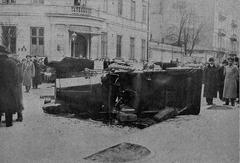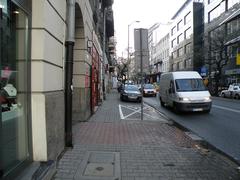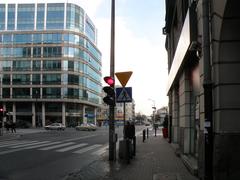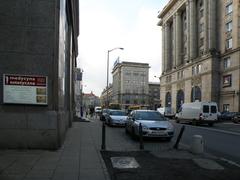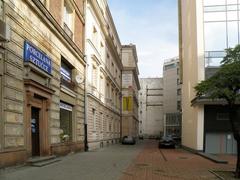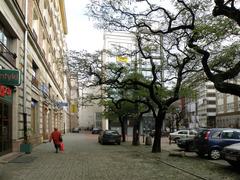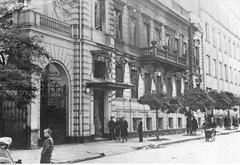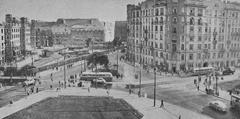
Piękna Street, Warsaw: A Complete Guide to Visiting Hours, Tickets, and Historical Sites
Date: 15/06/2025
Introduction
Piękna Street—literally “Beautiful Street”—is a captivating thoroughfare in Warsaw’s Śródmieście district, where architectural heritage and contemporary urban life meet. Its history spans over a century and a half, reflecting Warsaw’s resilience, creativity, and cosmopolitan spirit. From late 19th-century Eclectic and Art Nouveau tenements to modern developments, Piękna Street is a living archive of Poland’s capital. This guide covers the history, architectural highlights, cultural significance, visiting hours, ticketing, accessibility, and nearby attractions, ensuring you experience all that Piękna Street has to offer (whitemad.pl, koszyki.com).
Historical Overview
Origins and Development
Established in the late 19th century during Warsaw’s expansion under Russian Partition, Piękna Street quickly became a prestigious address for the city’s intelligentsia, doctors, artists, and business leaders. The street’s elegant tenement houses were commissioned by affluent families and designed by some of Warsaw’s foremost architects (whitemad.pl).
Architectural Evolution
Eclecticism and Art Nouveau
Early 20th-century Piękna Street featured an array of Eclectic and Art Nouveau buildings. The tenement at Piękna 47/Koszykowa 64 (1904–1911), designed by Henryk Stifelman and Stanisław Weiss, is a prime example, with its ornate facades and modernist touches. This building was recognized as a monument in 2024 for its historic and architectural value (whitemad.pl).
Modernism and Functionalism
The interwar period brought modernist and functionalist influences. Geometric forms and streamlined designs catered to professionals seeking comfort and amenities (koszyki.com).
Post-War Reconstruction
Though Warsaw suffered extensive damage during WWII, many Piękna Street buildings survived or were restored. Post-war reconstruction introduced Socialist Realist elements, blending pre-war and contemporary styles (blog.kurby.ai).
Today
Modern Piękna Street is a dynamic blend of restored historic buildings, embassies, trendy restaurants, and new residential complexes (shortstaypoland.com).
Cultural and Social Significance
Hub for Intelligentsia
Historically, Piękna Street was home to luminaries such as aviator Stanisław Wigura (66 Piękna Street) and singer Mieczysław Fogg. The street’s salons, cafés, and literary venues fostered intellectual and artistic life—an atmosphere that persists today in establishments like Łaskawość Tytusa (starwinelist.com).
Wartime and Resistance
During WWII, Piękna Street played a role in the Polish resistance. Some buildings served as clandestine meeting points for underground fighters (whitemad.pl).
Post-War Revival
Post-war, the street became a symbol of Warsaw’s rebirth, hosting embassies and cultural institutions, and remaining a favored address for the city’s elite (shortstaypoland.com).
Architectural and Historic Highlights
- Tenement at Piękna 47/Koszykowa 64: A registered monument with dual facades and modernist details (whitemad.pl).
- Ministry of Foreign Affairs (Piękna 13): An imposing neoclassical building from the 1920s.
- Embassy Row: Includes the embassies of Canada and Spain, housed in elegant historic and modernist villas.
Visiting Piękna Street: Practical Information
Visiting Hours and Tickets
- Street Access: Piękna Street is a public street, accessible 24/7 with no entrance fee.
- Cultural Venues and Museums: Opening hours vary. For example:
- National Museum: Tues–Sun, 10:00–18:00; tickets required.
- Hala Koszyki: Daily, 8:00–23:00; free entry.
- Ujazdowski Park and Łazienki Park: Open daily, dawn to dusk; free entry (thesimpletravel.com).
Accessibility
The street is pedestrian-friendly, with wide sidewalks and bike lanes. Most nearby museums, parks, and restaurants are wheelchair accessible. The nearest metro station is Politechnika, about a 10-minute walk away.
Getting There
- Metro: Politechnika or Centrum stations.
- Tram/Bus: Numerous lines serve the area.
- On Foot: Piękna Street is centrally located and easy to reach from key city landmarks.
Guided Tours and Photographic Opportunities
Numerous local operators offer guided walking tours focused on Piękna Street’s history, architecture, and notable residents. Photography enthusiasts will enjoy the street’s ornate facades, embassy buildings, and lively café culture (wefreespirits.com).
Nearby Attractions
- Hala Koszyki: A historic market hall with restaurants and art spaces (koszyki.com).
- Łazienki Park: Warsaw’s largest green space, with palaces, gardens, and the Chopin Monument (thesimpletravel.com).
- Ujazdowski Park: Picturesque 19th-century park at the street’s eastern end.
- Plac Konstytucji: An example of socialist realist architecture and a hub for public events.
Dining, Nightlife, and Shopping
- Cafés and Restaurants: From French-style bakeries like Charlotte Menora to hearty Polish fare at U Szwejka, Piękna Street caters to all tastes (Travel Lingual).
- Nightlife: Nearby Koszykowa Street and Hala Koszyki offer lively bars and music venues (Travel Lingual).
- Shopping: Local boutiques and craft markets showcase Polish fashion, jewelry, and artisanal goods (Lonely Planet).
Events and Cultural Life
Piękna Street participates in Warsaw’s vibrant cultural calendar, with nearby venues hosting concerts, art exhibitions, and festivals such as Jazz na Starówce and the Warsaw Beer Festival (polskabee.com).
Frequently Asked Questions (FAQ)
Q: What are Piękna Street’s visiting hours?
A: The street is accessible 24/7. Museums and other venues set their own hours.
Q: Are there entrance fees?
A: Walking along Piękna Street is free. Some museums and attractions may charge fees.
Q: Is the area accessible for people with disabilities?
A: Most public spaces and attractions on or near Piękna Street are accessible.
Q: Are guided tours available?
A: Yes, various walking tours highlight the street’s architecture and history.
Q: How do I get to Piękna Street?
A: Use the metro (Politechnika or Centrum), trams, buses, or walk from nearby city centers.
Practical Tips
- Best Time to Visit: May–September for outdoor events and pleasant weather.
- Language: English is widely spoken in tourist venues.
- Safety: The area is safe, but standard city precautions apply.
- Currency: Polish złoty (PLN); credit cards are widely accepted.
Summary and Final Tips
Piękna Street is a microcosm of Warsaw’s rich history and dynamic present. Its blend of architectural styles, cultural venues, embassies, and lively cafés make it an essential stop for any visitor. With easy public transport access, guided tours, and a wealth of nearby attractions, Piękna Street offers a rewarding Warsaw experience. Ongoing preservation efforts, like the monument registration of the tenement at Piękna 47/Koszykowa 64, ensure its continued significance (whitemad.pl).
For the latest updates, events, and guided tours, consider downloading the Audiala app and following official Warsaw tourism sources.
Useful Links and Further Reading
- A Tenement House with Two Fronts: Warsaw’s Monument is an Important Testimony (Whitemad)
- Hala Koszyki: Warsaw’s Culinary Landmark (Koszyki.com)
- From Past to Present: The Evolution of Warsaw, Poland’s Architecture (Blog.kurby.ai)
- Piękna Street Apartments (ShortStayPoland.com)
- Great Wine Bars in Warsaw (StarWineList.com)
- Discover Piękna Street: Visiting Hours, Cultural Significance, and Essential Travel Tips (DestinationAbroad.co.uk)
- The 10 Best Tourist Attractions in Warsaw (TheSimpleTravel.com)
- Warsaw’s Festivals and Events (Polskabee.com)
- 10 Interesting Things to Do Around Warsaw Old Town (WeFreeSpirits.com)
- Travel Lingual: Things to Do in Warsaw
- Lonely Planet: Best Warsaw Travel Itinerary
- Kids in the City: What’s On in Warsaw
